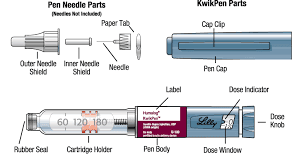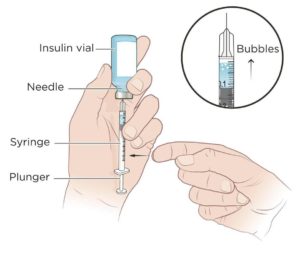What are the indications of Insulin treatment?
Type 1 diabetes: The pancreas produces very little or no insulin at all in people with type 1 diabetes. Hence all patients with type 1 diabetes will require insulin.
Patients of type 2 diabetes with the following conditions:
- Symptoms of weight loss, increase thirst and urination, what is known as ‘Osmotic symptoms”
- Kidney failure
- Severe infection and sepsis
- Before and after a surgery till recovery
- Acute complications like heart attacks, strokes etc.
- Beta cell failure: When pancreatic beta cells fail to produce insulin after long standing diabetes
- Pregnancy
Is my Diabetes in the last stage once I start Insulin therapy ?
This is a very common myth many patients have about insulin.
As stated above there are many indications of insulin therapy.
- Conditions like surgery, pregnancy and other acute illness are transient .
- Conditions like kidney failure and beta cell failure are usually permanent conditions when insulin may be continued for long term.
What is Beta cell failure?
Human pancreas has specific cells that produce insulin known as beta cells. These cells get damaged in type 1 diabetes by an antibody mediated process and hence these patients are insulin deficient from diagnosis.
In type 2 diabetes there is insulin resistance with progressive beta cell damage over a period of time. Hence insulin deficiency sets in late, on an average 8-10 years of duration of diabetes.
Sulphonylurea class of drugs mainly require functioning beta cells for their action. Thus, over period of time as beta cell function decreases these dugs become less effective and then there comes a point where beta cells are not making enough insulin. This is when we suspect “Beta Cell failure”.
Why is it necessary to start insulin in kidney failure?
Most oral drugs used for diabetes are excreted out from the body through the kidney. Hence when the kidney function declines i.e. kidney failure these medications stay a longer time in you body and can cause low sugars or other damage. Hence short acting insulin is what is preferred. However there are few oral medications which are safe to use which your doctor may recommend at times.
How many types of Insulin are available and which to choose?
There are several different types of insulin. These types are classified according to how quickly they begin working and how long the insulin lasts:
●Rapid acting (eg, insulin lispro [brand name: Humalog and Admelog], insulin aspart [brand name: NovoLog or Fiasp], and insulin glulisine [brand name: Apidra])
●Short acting (eg, insulin regular)
●Intermediate acting (eg, insulin NPH)
●Long acting (eg, insulin glargine [sample brand names: Lantus, Toujeo, and Basaglar], insulin detemir [brand name: Levemir], insulin degludec [brand name: Tresiba])
Most insulins are supplied in a concentration of 100 units per millilitre in pen forms and 40IU/ml in bottle forms. There are also more concentrated forms of insulin that can be used to control high blood sugar (hyperglycemia) that is not controlled by the usual types of insulin. Depending on the condition, comorbidity,age and many other variables your doctor will help you decide which insulin is best suited for you.
Why does my dose of insulin keep on changing frequently?
When you are first starting insulin, it will take some time to find the right dose. Your doctor will help to adjust your dose over time. You will be instructed to check your blood sugar level several times per day. Insulin needs often change over your lifetime.
Changes in weight, what you eat, health status (including pregnancy), activity level, and work can affect the amount of insulin needed to control your blood sugar.
The same dose of the same type of insulin may have different effects in different people with diabetes. Some trial and error is usually necessary to find the ideal type(s) and dose of insulin and schedule for each person. Most people will be able to learn to adjust their own insulin doses over period of time, although you will need help from time to time.
What are the different ways of taking insulin?
Insulin pen injectors — Insulin pen injectors may be more convenient to carry and use, particularly when you are away from home. Most are approximately the size of a large pen and contain a cartridge that contains the insulin, a dial to set the dose, and a button to deliver the injection.
A new needle must be attached to the pen prior to each injection. The needles are sold separately from the pens. The injection technique is like using a needle and syringe. Pens are generally more expensive than traditional syringes and needles.
Needle and syringe — One can also use a needle and syringe to draw up insulin from a bottle (vial) and inject the insulin under the skin.
The needle must be injected at the correct angle; injecting too deeply could deliver insulin to the muscle, where it may be absorbed too quickly. Injecting too shallowly deposits insulin in the skin, which is painful and also reduces complete absorption.
How do I store insulin and how long can I use it?
Insulin should always be kept in the refrigerator but never in the freezer section. In general, insulin bottles (vials), pens, and pen cartridges are good until their expirations date, if left unopened in a refrigerator. Insulin should never be allowed to freeze or get hot.
Once an insulin bottle (vial) is opened, it should be kept at room temperature or in the refrigerator for 28 to 30 days and then discarded. After a month, the potency begins to decrease. This can be a problem for people who require very small doses of insulin, for whom a bottle might last two months or more.
In general, it is advisable to open a new bottle at least every 30 days, even if there is insulin left in the old bottle. However, a few types of insulin can be used for up to 42 days.
For insulin pen devices, it is acceptable to keep the pen injector unrefrigerated (in a bag or jacket pocket) for varying amounts of time, depending upon the type of pen. Most opened insulin pens can be used for either 10, 14, or 28 days, but there are some pens that can be used for 42 or 56 days, depending upon the type of insulin in the pen.
Be sure you know how long your type of insulin pen is safe to use after opening.



